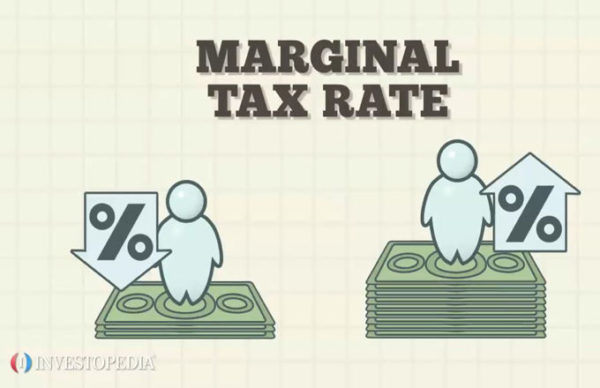
Sometimes it’s helpful to take a step back and start from the beginning. A flaw I’ve often seen when working with professionals (in all industries) is that they assume that everyone knows as much about their area of expertise as they do. This often leads to clients not fully understanding their own situation, simply because the professional doesn’t realize they need to take it slow and explain some things in a little more detail. In light of this, and since it is often a hot topic of conversation leading up to a major election, I wanted to do a quick review of a principle that is the foundation of the U.S. individual tax code: marginal tax rates.
Individual Tax Brackets are Progressive
This means that as your taxable income goes up, the tax rate that is applied to this income goes up as well. Seems obvious so far, right? This gives us a tax table that looks something like this for single filers:
| Taxable Income ($) | Marginal Tax Rate (%) |
|---|---|
| 0 to 9,275 | 10% |
| 9,276 to 37,650 | 15% |
| 37,651 to 91,150 | 25% |
| 91,151 to 190,150 | 28% |
| 190,151 to 413,350 | 33% |
| 413,351 to 415,050 | 35% |
| 415,051 and up | 39.6% |
Note: Your first thought might be, “I thought the first $6,300 was tax free?!” And you’d be right (you’re thinking of the standard deduction). The Taxable Income figures in the table above are already adjusted for items like the standard deduction, so if you earned $15,000 and took only the standard deduction of $6,300, your taxable income would be $8,700, which, according to the table, would be taxed at 10%.
This is where it can get confusing for some people. I have heard many business owners, both established and aspiring, say things like: “If I make another $1,500 it will push me into the next tax bracket and I’ll actually end up making less money!” This does not happen*. Why not? Because of marginal tax rates.
Marginal Tax Rates
Marginal tax rates mean that every taxpayer’s income, regardless of how large or small, is taxed according to a tax table like the one above. What makes it marginal is that not all of the income is taxed at the rate indicated by your total taxable income. Each taxpayer’s income climbs the ladder in the same way, meaning that the first $9,275 of taxable income (for every taxpayer) is taxed at 10%. The portion in the next bracket, $28,374 (37,650 less 9,276), is taxed at 15% for every taxpayer. And so on… Because of this, it is not possible that earning another $1,500 can cause you to earn less money after taxes.
An Example
Let’s look at an example: John Smith had $189,000 of taxable income during the year. His tax will be calculated as follows:
- The first $9,275 is taxed at 10% – the tax on this portion is $928
- His 9,276th dollar is now in the next bracket, and is therefore taxed at 15% (this does NOT change the fact that his first $9,275 was taxed at 10%) – he has a total of $28,374 (37,650 less 9,276) in this bracket, which, at 15%, generates another $4,256 of tax
- His 37,651st dollar is now in the third bracket, and is therefore taxed at 25% – he has a total of $53,499 (91,150 less 37,651) in this bracket, which, at 25%, generates another $13,375 of tax
- His 91,151st dollar is in the fourth bracket, and is therefore taxed at 28% – he has a total of $97,849 in this bracket which, at 28%, generates $27,398 of tax (Note: we got $97,849 from 189,000 less 91,151 – we used 189,000 here, not 190,150, which is the top end of the bracket, because Mr. Smith’s taxable income was 189,000, and he’s not going to be taxed on more than his income)
So, what is Mr. Smith’s total tax? We add up the tax calculated in each bracket (928 + 4,256 + 13,375 + 27,398) and get $45,957 of total income tax for the year. His take home earnings would be $143,043.
What If Mr. Smith Earned Another $1,500?
You’ve probably figured this out by now, but let’s say that Mr. Smith is given the opportunity to work a little overtime and pick up another $1,500 of taxable income. This would push his total taxable up from $189,000 to $190,500, which puts him in the 33% tax bracket. However, as we now know, only the amount in excess of the previous bracket (any amount above $190,150) is taxed at this higher rate, so Mr. Smith would only have $350 (190,500 less 190,150) of his income taxed at 33%. The additional $1,500 income would be taxed as follows:
- $1,150 would be taxed at 28% (to fill up the rest of the fourth bracket on top of his already existing $189,000 of income), meaning $322 of tax
- $350 would be taxed at 33%, meaning $116 of tax
Mr. Smith’s additional $1,500 of taxable income would generate an additional $438 of tax, so he’d take home an additional $1,062.
What If Mr. Smith Earned Another $1,500, but He Hadn’t Read this Post?
If Mr. Smith hadn’t read this blog post, he might not know about marginal tax rates, and he might be tempted to think that all of his income is taxed at the tax rate corresponding with his total taxable income on the tax table. Here’s how Mr. Smith might (incorrectly) calculate his tax:
- Without the $1,500 of overtime: $189,000 of taxable income * 28% = $52,920 of tax, meaning his take-home earnings would be $136,080 (189,000 less 52,920 of tax)
- With the $1,500 of overtime: $190,500 of taxable income * 33% = $62,865 of tax, meaning his take-home earnings would be $127,635 (190,500 less 62,865 of tax), which is significantly lower than his take home pay had he not earned the additional $1,500 – this is NOT how the tax code works – earning more will never* decrease your take home pay
Wrapping Up
Thanks to marginal tax rates, earning more will not* decrease your take-home pay, even if it pushes you into the next tax bracket, since you are only taxed in each bracket on the marginal amount in excess of the amounts already taxed in previous bracket(s).
Bonus Lesson: Effective Tax Rate
Sometimes, especially around election time, you might hear mention of an “effective tax rate”. This is calculated by taking the total tax for the year and dividing it by the taxable income for the year. In Mr. Smith’s case, that would be $45,967 / $189,000, and would result in an effective tax rate of 24.32%, which, because of the way that marginal tax rates work, is notably lower than the rate for his top bracket, which was 28%. When you factor in other tax deductions, favorable tax rates (for items like long-term capital gains and qualified dividends), and tax credits, it is very common for a taxpayer’s effective tax rate to be lower than the tax rate that corresponds with their taxable income on the tax table.
* There are instances where earning more can decrease your after-tax earnings because of specific tax credits being phased out all at once instead of dollar-for-dollar, but it is an extreme rarity and is beyond the scope of this post. If you want to learn more about this, drop me a line and we can talk it out.
Note: This post is with regards to the Federal income tax, and while some states have marginal tax brackets like this, not all do, and some have no income tax at all.
